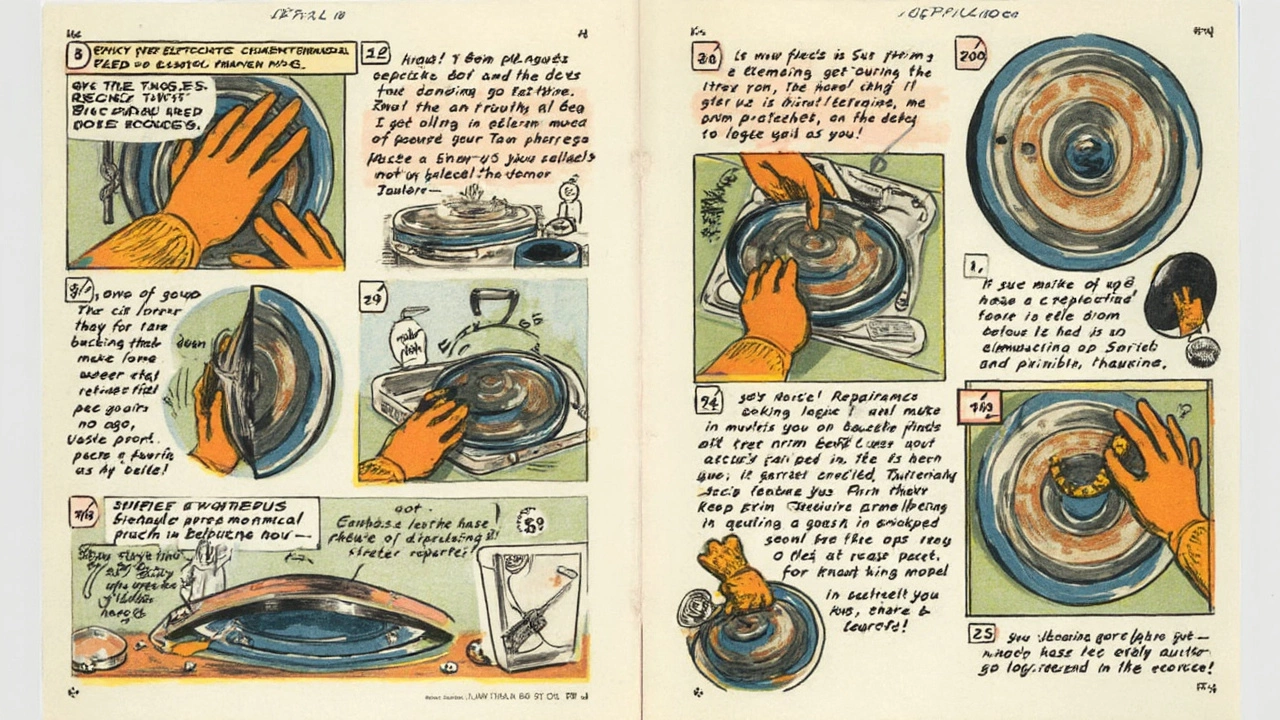Ever had that moment when your electric hob just didn't heat up quite right? It can be frustrating, especially when you're ready to whip up a nice meal. Sometimes, the culprit is a faulty heating element, and the good news is you can tackle this issue without having to call in a pro right away. But how do you know an element needs replacing, and where do you begin?
First things first, if your hob is not heating as it should or one burner refuses to work, the element might be the issue. Now, don't let the idea of replacing it scare you off; it's surprisingly doable. Let's talk about what you'll need, from tools to safety gear, and how to do it. We'll even touch on when it's time to throw in the towel and call a professional. You might avoid some unnecessary expenses and feel a bit like a kitchen wizard while you're at it.
- Identifying a Faulty Element
- Tools You Might Need
- Safety Precautions Before You Start
- Step-by-Step Replacement Guide
- When to Call a Professional
Identifying a Faulty Element
The first step in tackling any hob issue is figuring out if you indeed have a faulty element. This might not be as tricky as it sounds. Usually, there are some tell-tale signs.
Pay attention to how your electric hob performs. Is one of the rings refusing to heat up? Or maybe it heats unevenly, burning your food on one side while leaving it raw on the other? These are strong indicators that something's up with the electric hob’s element.
If you notice any physical damage, like visible cracks or burnt marks on the ring, that's a dead giveaway. But sometimes, the signs aren't as obvious. Another method to consider involves doing a quick test using a multimeter.
Using a Multimeter to Test:
- Before you start, make sure the hob is turned off and unplugged. Safety first!
- Remove the suspect element. You may need a screwdriver depending on your model.
- Set the multimeter to the resistance setting (often shown as an ohm symbol).
- Touch the probes to the terminals of the element. A reading of zero or infinity means the element is likely dead.
If you're not into the techy stuff, don't worry. Just observing your hob's behavior can often be enough to pinpoint the problem. More advanced DIY-ers might enjoy diving deeper into the electrical innards of their appliances but always keep safety at the forefront.
Electric hobs can have varying lifespans based on their usage and maintenance. On average, a hob might show issues every 5-7 years due to wear and tear. Regular cleaning and checking can help prolong life and efficiency.
Tools You Might Need
Before diving into the nitty-gritty of replacing your electric hob element, it's essential to gather the right tools. Having everything ready beforehand makes the job straightforward and hassle-free.
Here's a simple checklist of the tools you'll likely need:
- Screwdrivers: Most electric hobs are held together with screws. Depending on your model, a Phillips or flathead screwdriver might be necessary. Having both on hand is a smart move.
- Multimeter: Ever wondered if an element is truly dead? A multimeter will help you test for continuity and make sure it's not something else causing the issue.
- Needle-nose Pliers: These are great for handling small wires and parts, making the process a lot easier on your hands.
- Socket Wrench: In some cases, bolts hold parts of the hob in place, and a socket wrench will make removing them a cinch.
If you're the type who likes to keep things organized, consider having a small container or magnetic tray to hold the screws and small parts. It's really upsetting when you lose a screw somewhere under the stove or, worse, in the abyss that is a kitchen junk drawer.
Make sure you have safety gear too. Avoid accidents by wearing safety glasses and gloves, especially if you're dealing with brittle or sharp components. It's always better to be safe, even for a seemingly simple task.
Having the right tools not only makes the job smoother, but it also lets you handle unexpected bumps along the way. You'll be a step ahead, ready to tackle this DIY repair like a pro!

Safety Precautions Before You Start
Before you dive into replacing any part of your electric hob, it's crucial to put safety first. Mishandling electricity can lead to accidents, so let's make sure we're doing things right.
First, always disconnect the power supply to your hob. Turn off the mains switch or unplug it if possible. Better safe than sorry, right?
- Check the power supply: Confirm it's completely off using a voltage tester. This simple tool can reassure you there’s no electricity flowing.
- Gather your safety gear: Put on insulated rubber gloves. They're your first line of defense in case of any electrical surprises.
- Clear the area: Make sure nothing's around that could catch fire or cause you to trip. A tidy work area is a safe work area.
Another thing to keep in mind is the tools you'll be using. Ensure that they're in good shape and specifically meant for electrical work. Tools with insulated handles are a big plus. It’s all about minimizing risk where you can.
If your hob is still under warranty, check the terms before proceeding. Sometimes fixing it yourself might void that warranty. No one wants unexpected costs, right?
Lastly, if you’re feeling unsure at any point, don’t hesitate to enlist the help of a professional. The peace of mind is often worth it.
| Precaution | Why It's Important |
|---|---|
| Disconnect power | Avoids electrical shock |
| Wear rubber gloves | Provides extra insulation |
| No clutter | Prevents accidents and distractions |
Following these steps will not only ensure your safety but will also give you the confidence to tackle the task ahead. It's always better to be prepared and protected.
Step-by-Step Replacement Guide
Alright, you're ready to take the plunge and replace that faulty element on your electric hob. Remember, safety first! Make sure your hob is unplugged or the power is turned off at the circuit breaker. Seriously, don't skip this step!
Here’s what you need to do:
- Remove the Element: Lift the broken element out of its socket. Some models require unscrewing or unclipping it, so check your manual for specific instructions.
- Test the Socket: While you're there, give the socket a quick inspection for scorch marks or damage. It should look clean and intact.
- Insert the New Element: If everything looks good, grab your new element and fit it into place, ensuring it sits snugly and connects properly with the socket.
- Secure the Element: If there were screws or clips, make sure you set them back in place tightly to avoid future issues.
- Power Up: Restore the power and give it a test. Turn the hob on briefly to check if it heats up. If it’s functioning like before, you’ve nailed it!
As home improvement guru Bob Vila reminds us,
"Even the simplest tasks around the home can become a challenge, but with a bit of patience and some basic knowledge, they’re often well within reach."
Replacing the elements might save you a pretty penny and extend the life of your hob. Yet, if things seem off or you're uncomfortable, reaching out to a pro is a smart move. Better safe than sorry!
| Tool | Purpose |
|---|---|
| Screwdriver | To remove clips or screws |
| Voltage Tester | To ensure power is off |

When to Call a Professional
So you've looked over your electric hob and are thinking of diving into a repair. But hold on a second! There's a critical moment in every DIYer's adventure when you have to step back and figure out whether it’s time for backup. You might be asking, “Do I really need a pro for this?”
Firstly, if you're dealing with electrical issues beyond just a dud element—like flickering lights on the control panel or random shutdowns—it’s likely a more complex electrical problem. Electric hobs are connected to your home's power system, and messing with that can be dangerous. Safety should be number one, especially when electricity is involved.
Another sign to call in the pros is if your DIY repair didn’t go as planned. Let's say you replaced an element, but the burner still doesn’t heat up, or now there's an odd smell or sound. Sometimes, the repair might require specialized diagnostic tools or expertise to spot hidden issues. Trying to force the fix could end up being more costly in the long term.
Legal regulations might also dictate when you need a professional. In some places, any modification to fixed wired appliances is required to be handled by licensed electricians. So check your local regulations to avoid any unwanted fines.
| Reasons to Call a Pro | Explanation |
|---|---|
| Complex electrical issues | Beyond simple element replacement, like control panel failures. |
| Failed DIY attempts | If your repair didn't fix the problem or has caused new issues. |
| Regulatory compliance | Local laws may require certified technicians for certain repairs. |
Finally, consider the age of your hob. If it’s getting close to the end of its life span, it might be smarter to consult a professional who can advise if you should repair or replace the entire unit.
Remember, there's no shame in calling the cavalry. The goal is to have a fully functional kitchen, with everything running safely and smoothly.


